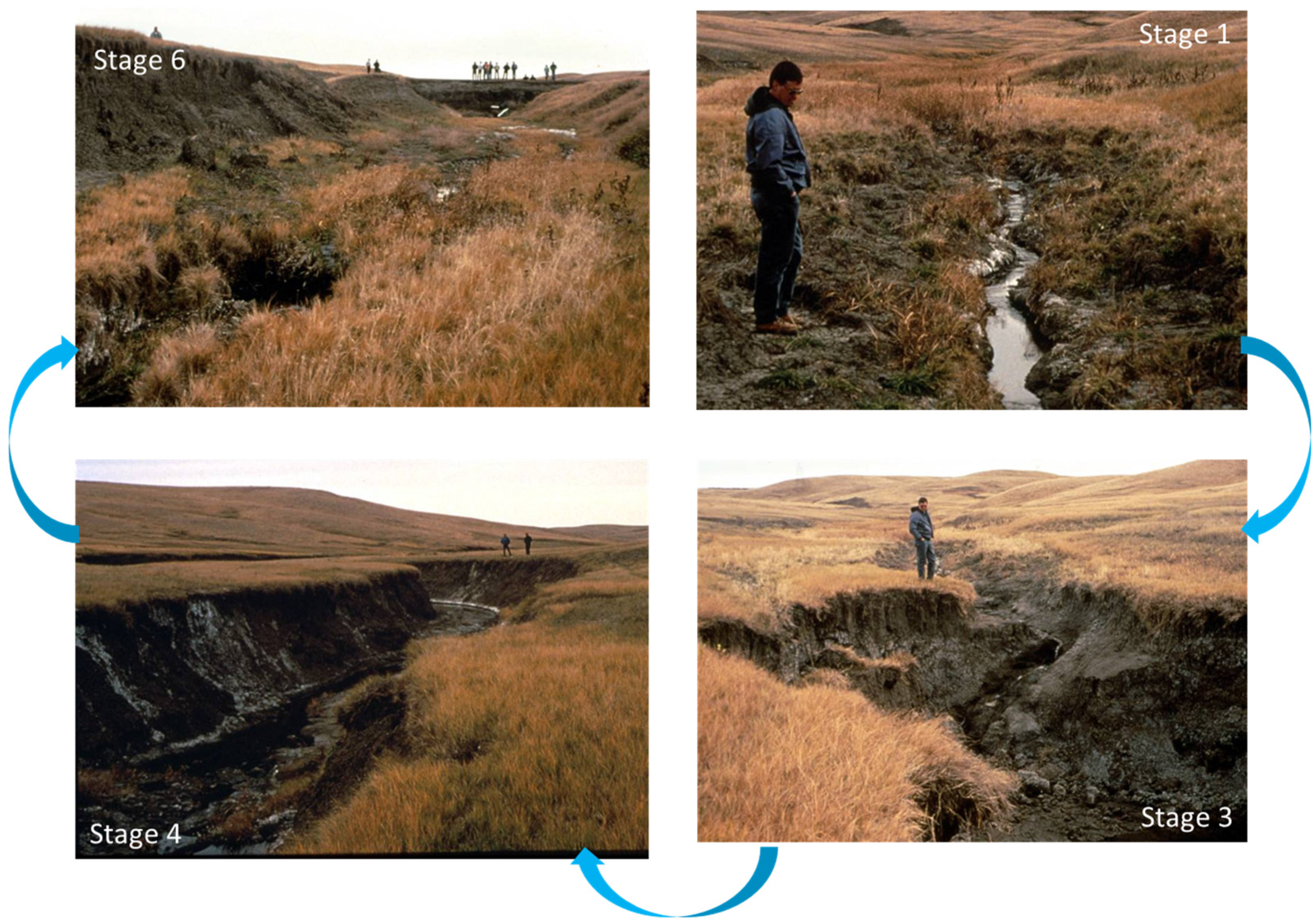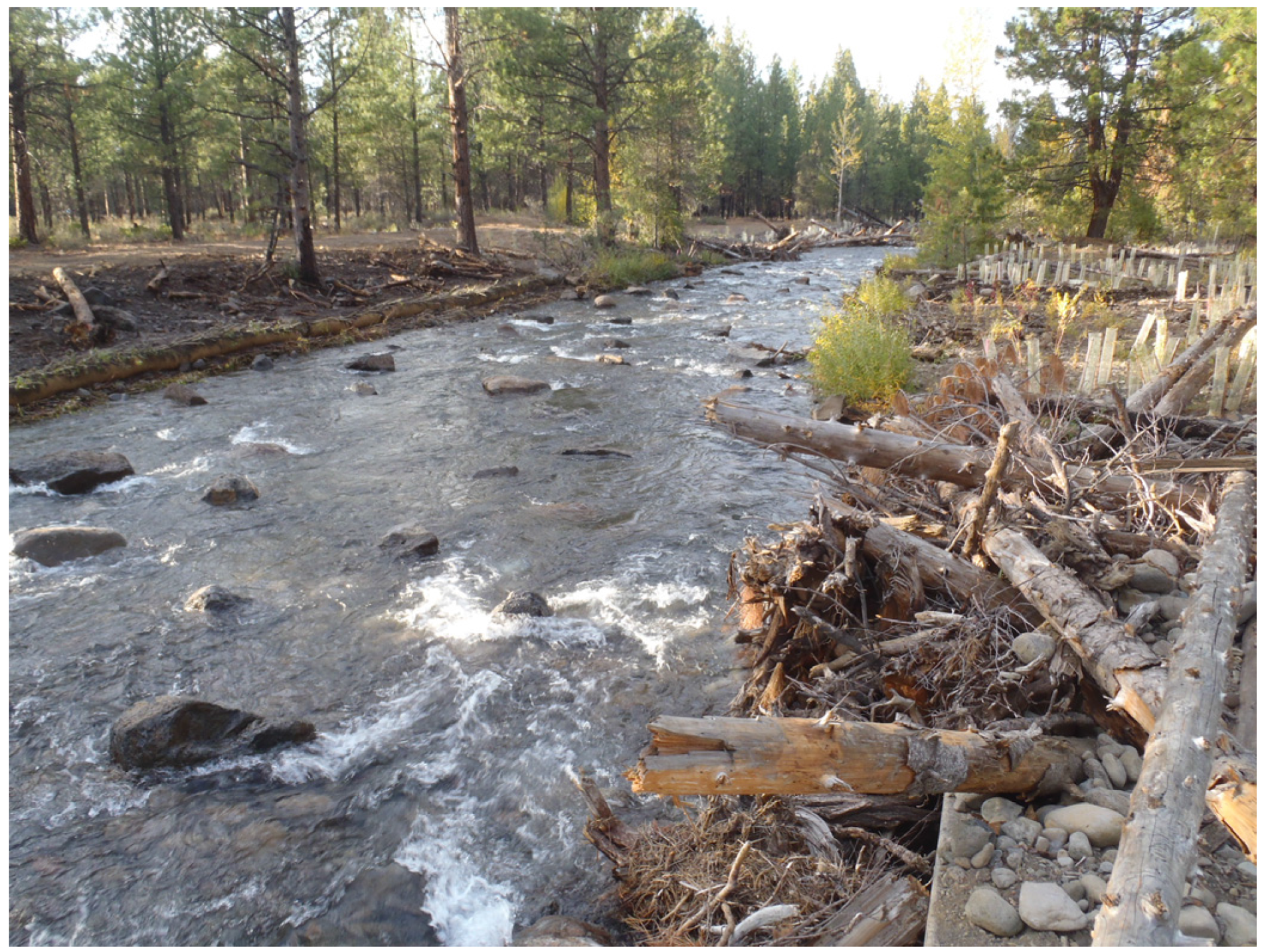Providing Aquatic Organism Passage in Vertically Unstable Streams
Abstract
:1. Introduction
1.1. Background
1.1.1. Incision Processes
1.1.2. Stream Impacts from Undersized Culverts
1.1.3. Stream Impacts from Channel Incision
- Upstream migrating channel incision and subsequent channel deepening;
- Increased bank height—if critical height is exceeded, bank erosion results;
- Increased sediment supply due to erosion of the channel boundary;
- Disconnection of floodplains from active stream channels;
- Prematurely dewatered or disconnected backwater habitat;
- Locally increased channel slope and loss of pool habitat;
- Drainage of shallow aquifers, thus affecting riparian vegetation, adjacent wetlands, and base flows;
- Increased meander cut-offs due to knickpoint migration across a meander neck caused by an increased elevation drop (head differential) between the old floodplain and active channel bed; and
- Downstream channel aggradation resulting in localized channel braiding.
2. Methods
2.1. Stream Evolution Model
- Headcuts in the stream bed—a vertical drop or off-set in the channel profile;
- Lack of pool habitat in low gradient streams;
- No sediment deposits on the channel bed—scour to bedrock or resistant layer;
- Dead or dying riparian vegetation as a result of dewatering of the shallow groundwater;
- Vertical streambanks on both banks that extend down to the toe of the slope;
- Bank seepage due to dewatering of aquifers;
- Exposed cultural features, such as bridge piers, footings, and aprons, pipelines, or perched culverts; and
- Upland vegetation encroaching into floodplains and riparian areas indicating decreased moisture.
2.2. Stream Profile Analysis
2.3. Post-Project Monitoring
2.4. Risk Assessment
Upstream headcut migration.
- Will the headcut cause an AOP barrier in the channel or at an upstream structure?
- What is the likelihood that grade control (i.e., bedrock, boulders, or wood) will be encountered and how far is it from the project site?
- Is there other infrastructure, such as upstream road crossings, pipelines, diversions, or communication cables that will be affected?
- Will headcut migration across a meander neck caused by an increased elevation drop between the old floodplain and active channel bed result in a meander cut-off?
High channel banks that may result in mass failure.
- How much bank erosion, both the total area affected and the amount of sediment produced, will likely occur?
- Is bank stabilization necessary due to instream or adjacent structures?
Fine sediment inputs to the stream system.
- Is the stream water quality limited due to fine sediment or contaminated soil?
- What is the caliber of sediment (clay, silt, sand) and will the sediment impact habitat or increase turbidity?
Disconnection of floodplains.
- How often will the abandoned floodplain be inundated—once every 2, 5, 10, 100-years?
- Will increased flow confinement significantly increase stream power within the main channel?
Prematurely dewatered or disconnected backwater habitat.
- Will backwater habitat be completely disconnected or will it be functional for much shorter periods during the year?
- Will disconnection of habitats cause stranding for aquatic species?
Locally increased channel slope and loss of pool habitat.
- Are a lack of pools an aquatic habitat limiting factor?
- Is pool quality, especially residual pool depths, an aquatic habitat limiting factor?
Drainage of shallow aquifers which affects riparian vegetation.
- Can the riparian vegetation survive a drop in the water table commensurate with expected incision?
- Will monitoring of the plant community be used to determine if wetland species are affected by changes in moisture regimes?
Sediment deposition causing localized channel braiding and instability of the streambanks.
- Is deposition of coarse sediment en masse likely?
- Will mid-channel bar formation cause concentrated flow near stream banks?
- Is local aggradation causing a shallow, wide channel a concern for AOP?
3. Applications
3.1. Geomorphic Approaches
3.2. Grade Control Treatments
3.2.1. The “Do Nothing” Alternative
3.2.2. Large Roughness Elements: Wood and Boulders
3.2.3. Constructed Riffles
3.2.4. Constructed Steps
3.2.5. Constructed Cascades
4. Conclusions
Acknowledgments
Author Contributions
Conflicts of Interest
References
- Nehlsen, W.; Williams, J.E.; Lichatowich, J.A. Pacific salmon at the crossroads: Stocks at Risk from California, Oregon, Idaho, and Washington. Fisheries 1991, 16, 4–21. [Google Scholar] [CrossRef]
- Forman, R.T.; Alexander, L.E. Roads and their major ecological effects. Annu. Rev. Ecol. Syst. 1998, 29, 207–231. [Google Scholar] [CrossRef]
- Hoffman, R.L.; Dunham, J.B.; Hansen, B.P. Aquatic Organism Passage at Road-Stream Crossings—Synthesis and Guidelines for Effectiveness Monitoring; Open-File Report 2012–1090; U.S. Geological Survey: VA, USA, 2012.
- Mallen-Cooper, M.; Brand, D.A. Non-salmonids in a salmonid fishway: What do 50 years of data tell us about past and future fish passage? Fish. Manag. Ecol. 2007, 14, 319–332. [Google Scholar] [CrossRef]
- Noonan, M.J.; Grant, J.W.A.; Jackson, C.D. A quantitative assessment of fish passage efficiency. Fish Fish. 2012, 13, 450–464. [Google Scholar] [CrossRef]
- United States Forest Service (USFS). Stream Simulation: An Ecological Approach to Providing Passage for Aquatic Organisms at Road-Stream Crossings; National Technology and Development Program; U.S. Department of Agriculture, Forest Service National Technology and Development Program: San Dimas, CA, USA, 2008.
- Castro, J. Geomorphologic Impacts of Culvert Replacement and Removal: Avoiding Channel Incision; Unpublished Report; US Fish and Wildlife Service: Portland, OR, USA, 2003.
- Barnard, R.J.; Yokers, S.; Nagygyor, A.; Quinn, T. An evaluation of the stream simulation culvert design method in Washington State. River Res. Appl. 2014, 31, 1376–1387. [Google Scholar] [CrossRef]
- Schumm, S.A.; Harvey, M.; Watson, C. Incised Channels: Morphology, Dynamics, and Control; Water Resources Publications: Littleton, CO, USA, 1984. [Google Scholar]
- Love, M.; Bates, K. Part XII: Fish passage design and implementation. In California Salmonid Stream Habitat Restoration Manual; California Department of Fish and Wildlife: Sacramento, CA, USA, 2009; p. 188. [Google Scholar]
- Booth, D.B. Urbanization and the natural drainage system—Impacts, solutions, and prognoses. Northwest Environ. J. 1991, 7, 93–118. [Google Scholar]
- Galay, V.J. Causes of river bed degradation. Water Resour. Res. 1983, 19, 1057–1090. [Google Scholar] [CrossRef]
- Skidmore, P.B.; Thorne, C.R.; Cluer, B.L.; Pess, G.R.; Castro, J.M.; Beechie, T.J.; Shea, C.C. Science Base and Tools for Evaluating Stream Engineering, Management, and Restoration Proposals; NOAA Tech Memo, NMFS-NWFSC-112; U.S. Department of Commerce: Wahington, DC, USA, 2011; p. 255.
- Jones, J.A.; Swanson, F.J.; Wemple, B.C.; Snyder, K.U. Effects of roads on hydrology, geomorphology, and disturbance patches in stream networks. Conserv. Biol. 2000, 14, 76–85. [Google Scholar] [CrossRef]
- Lane, E.W. Design of stable alluvial channels. Trans. Am. Soc. Civ. Eng. 1955, 120, 1234–1260. [Google Scholar]
- Rosenberg, D.K.; Noon, B.R.; Meslow, E.C. Biological corridors: Form, function, and efficacy. Bioscience 1997, 47, 677–687. [Google Scholar] [CrossRef]
- Lang, M.; Love, M.; Trush, W. Improving Fish Passage at Road Crossings; Final Report to the National Marine Fisheries Service, Produced in Cooperation with Humboldt State University Foundation under NMFS; Contract 50ABNF800082; NMFS: Arcata, CA, USA, 2004; p. 128.
- Mooney, D.M.; Holmquist-Johnson, C.L.; Holurn, E. Qualitative Evaluation of Rock Weir Field Performance and Failure Mechanisms; U.S. Department of the Interior, Bureau of Reclamation, Sedimentation and River Hydraulics Group, Technical Service Center: Denver, CO, USA, 2007.
- Price, D.M.; Quinn, T.; Barnard, T.J. Fish passage effectiveness of recently constructed road crossing culverts in the Puget Sound region of Washington state. N. Am. J. Fish. Manag. 2010, 30, 1110–1125. [Google Scholar] [CrossRef]
- Furniss, M.J.; Ledwith, T.S.; Love, M.A.; McFadin, B.A.; Flanagan, S.A. Response of Road-Stream Crossings to Large Flood Events in Washington, Oregon, and Northern California; 9877 1806-SDTDC; U.S. Forest Service: San Dimas, CA, USA, 1998.
- Tsihrintzis, V. Effects of sediment on drainage-culvert serviceability. J. Perform. Constr. Facil. 1995, 9, 172–183. [Google Scholar] [CrossRef]
- Thompson, P.; Kilgore, R. Hydraulic design of energy dissipators for culverts and channels. In Hydraulic Engineering Circular No. 14, 3rd ed.Federal Highways Administration, National Highway Institute: Washington, DC, USA, 2006. [Google Scholar]
- Simon, A.; Rinaldi, M. Channel instability in the loess area of the Midwestern United States. J. Am. Water Resour. Assoc. 2000, 36, 133–150. [Google Scholar] [CrossRef]
- Cluer, B.; Thorne, C.R. A stream evolution model integrating habitat and ecosystem benefits. River Res. Appl. 2014, 30, 135–154. [Google Scholar] [CrossRef]
- Simon, A.; Hupp, C.R. Channel evolution in modified Tennessee channels. In Proceedings of the Fourth Federal Interagency Sedimentation Conference, Las Vegas, NV, USA, 24–27 March 1986; Volume 2.
- Harrelson, C.C.; Rawlins, C.L.; Potyondy, J.P. Stream Channel Reference Sites: An Illustrated Guide to Field Technique; General Technical Report RM-245; U.S. Department of Agriculture, Forest Service, Rocky Mountain Forest and Range Experiment Station: Fort Collins, CO, USA, 1994.
- Barnard, R.J.; Johnson, J.; Brooks, P.; Bates, K.M.; Heiner, B.; Klavas, J.P.; Ponder, D.C.; Smith, P.D.; Powers, P.D. Water Crossings Design Guidelines; Washington Department of Fish and Wildlife: Olympia, DC, USA, 2013.
- Thorncraft, G.A.; Harris, J.H. Assessment of Rock-Ramp Fishways; NSW Fisheries Research Institute and the Cooperative Research Center for Freshwater Ecology: Pyrmont, Australia, 1996. [Google Scholar]
- Bates, K. Design of Culverts for Fish Passage; Washington Department of Fish and Wildlife: Olympia, Washington, DC, USA, 2003.
- Mooney, D.M.; Holmquist-Johnson, C.L.; Broderick, S. Rock Ramp Design Guidelines; U.S. Department of the Interior Bureau of Reclamation, Sedimentation and River Hydraulics Group, Technical Service Center: Denver, CO, USA, 2007.
- Lorenz, E.A.; Lobrecht, M.N.; Robinson, K.M. An excel program to design rock chutes for grade stabilization. In Proceedings of the ASAE Annual International Meeting, Milwaukee, WI, USA, 9–12 July 2000; pp. 1–22.
- Keller, R.J. Guidelines for the Design of Rock Chutes Using CHUTE; Cooperative Research Centre for Catchment Hydrology: Melbourne, Australia, 2003. [Google Scholar]
- Newbury, R.W.; Gaboury, M.N. Stream Analysis and Fish Habitat Design; A Field Manual; Newbury Hydraulics: Gibsons, BC, Canada, 1993; p. 256. [Google Scholar]
- Newbury, R.N.; Gaboury, M.N.; Bates, D. Restoring habitats in channelized or uniform streams using riffle and pool sequences. In Fish Habitat Rehabilitation Procedures; Watershed Restoration Technical Circular; Slaney, P.A., Zaldokas, D., Eds.; Ministry of Environment, Lands and Parks, and Ministry of Forests: Vancouver, BC, Canada, 1997; Volume 9, Chapter 12; p. 341. [Google Scholar]
- Montgomery, D.R.; Buffington, J.M. Channel Classification, Prediction of Channel Response, and Assessment of Channel Condition: Olympia, Washington; Washington State Department of Natural Resources Report; TFW-SH10-93-002; Washington State Department of Natural Resources: Olympia, DC, USA, 1993; p. 86.
- Montgomery, D.R.; Buffington, J.M. Channel-reach morphology in mountain drainage basins. Geol. Soc. Am. Bull. 1997, 109, 591–611. [Google Scholar] [CrossRef]
- Montgomery, D.R.; Buffington, J.M. Channel processes, classification, and response. In River Ecology and Management: Lessons from the Pacific Coastal Region, 1st ed.; Naiman, R.J., Bilby, R.E., Kantor, S., Eds.; Springer: New York, NY, USA, 1998; pp. 13–42. [Google Scholar]
- Frissell, C.; Nawa, R. Incidence and causes of physical failure of artificial habitat structures in streams of western Oregon and Washington. N. Am. J. Fish. Manag. 1992, 12, 182–197. [Google Scholar] [CrossRef]
- Holburn, E.; Varyu, D.; Russell, K. Quantitative Investigation of the Field Performance of Rock Weirs; U.S. Department of the Interior Bureau of Reclamation Technical Service Center: Denver, CO, USA, 2009.
- Rosgen, D.L. The cross-vane, w-weir and j-hook vane structures...their description, design and application for stream stabilization and river restoration. In Proceedings of the 2001 Wetlands Engineering & River Restoration Conference, Reno, NV, USA, 27–31 August 2001.













| Decreased Erosional Resistance |
|---|
|
| Increased Erosional Forces |
|
| Alternative | Common Benefits | Potential Limitations |
|---|---|---|
| Do Nothing |
|
|
| Large Roughness Elements: Wood and Boulders |
|
|
| Constructed Riffles |
|
|
| Constructed Steps |
|
|
| Constructed Cascades |
|
|
© 2016 by the authors; licensee MDPI, Basel, Switzerland. This article is an open access article distributed under the terms and conditions of the Creative Commons by Attribution (CC-BY) license (http://creativecommons.org/licenses/by/4.0/).
Share and Cite
Castro, J.M.; Beavers, A. Providing Aquatic Organism Passage in Vertically Unstable Streams. Water 2016, 8, 133. https://doi.org/10.3390/w8040133
Castro JM, Beavers A. Providing Aquatic Organism Passage in Vertically Unstable Streams. Water. 2016; 8(4):133. https://doi.org/10.3390/w8040133
Chicago/Turabian StyleCastro, Janine M, and Aaron Beavers. 2016. "Providing Aquatic Organism Passage in Vertically Unstable Streams" Water 8, no. 4: 133. https://doi.org/10.3390/w8040133





